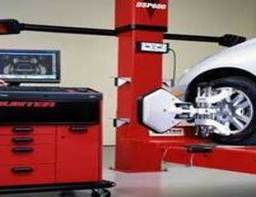
Although this page is about the wheel alignment service I do realize that you will not be able to perform this on your own.
My goal here is to provide some information that will give you an increased chance of receiving a quality front end alignment. This service procedure is oversimplified by repair centers. It’s often up sold when you purchase tires or going in for regular maintenance.
Sometimes the service writer will make it seem like a quick and easy add on that’s well worth the money. I don’t debate the value of alignments when they’re needed. The question is will they actually take the time to do all of the adjustments, or will they just set the tow and let it go?
On many modern day vehicles only the toe setting is adjustable. If other angles are out of adjustment from the factory issued specifications it will cost more to have these adjusted.
Operations like elongating holes, adding shims or installing cam kits can require labor intensive and costly modifications. This can be a sticky situation when the customer signed up for the $29.95 alignment special and then gets a call back stating more work is required.
Customers can get suspicious and start wondering if fraud is a foot. From the shops point of view they must walk the line between what is needed, balanced with the best interest of the customer.
At the same time they are trying to recover revenue the shop owner shelled out on expensive equipment. I think alignments can provide value when they’re truly needed.
Modern equipment is capable of providing extremely accurate readings. However, it relies on the technician that’s operating the rack. Learning about the adjustable angles and asking for a print out of the before and after readings can increase the chances of getting a good alignment.
Front End Toe Setting
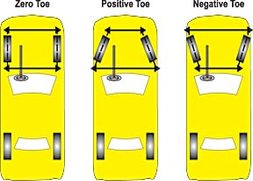
This is the most common angle set during a wheel alignment. All vehicles have adjustable front toe settings and some even have adjustable rear toe settings.
When the rear end of the vehicle is adjustable it is known as a four wheel alignment. Four wheel alignments usually cost extra but are necessary on vehicles that have rear adjustments.
All rear adjustments are made prior to taking readings on the front wheels. If the rear settings are out it can cause the vehicle to dog track. This is a condition where the rear end of the vehicle is out of alignment with the front as it travels down the road.
Toe is the distance comparison between the front edges and rear edges of the tires and exactly how far apart they are from each-other.
If the front of the tire is measured and the reading is less than the reading taken at the back of the tires this is known as a toe in condition.
If the vehicle has too much toe in, not only will the tires wear faster but this can also cause unnecessary drag. Drag or rolling resistance might reduce fuel economy if out of specifications.
Professional 1/4 mile racers always set their front toe to zero or at least as close as they can get to it. This means that there is no toe in or toe out. This provides the best rolling condition with less tire friction. Most passenger vehicles will require some toe in for stability and to prevent wandering.
About Caster Settings
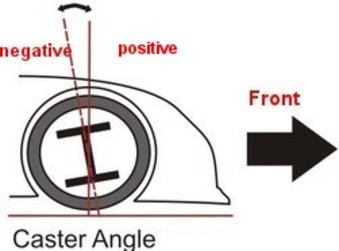
My automotive instructor always referenced a shopping carts front wheels when discussing this angle. Castor is the angle of the steering axis of a wheel as viewed from the side of the vehicle.
There are three types of Castor measurements. Zero Castor is when the wheel is completely vertical and centered. Negative Castor is when the top of the wheel is slightly towards the back of the vehicle.
Positive Castor is when the top of the wheel is forward and towards the front of the vehicle. Your standard shopping cart uses a lot of positive Castor. This helps it set out straight again after you spin it around in the aisle to head in the opposite direction.
When you swing your shopping cart around it tends to straighten itself and track straight due to this positive Castor setting. An incorrect caster setting can cause both a pulling and a wandering condition.
The caster setting is also responsible for straightening the wheels automatically when you come out of a turn. If the steering wheel is slow to return to the center position on the car then this would be an indication that a caster adjustment may be needed.
Camber Wheel Alignment Settings
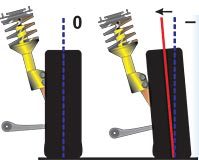
Camber is the angle represented by the tilt of either the front or rear wheels inward or outward as viewed from the front of the car. It is designed into the vehicle to compensate for road crown, passenger weight, as well as the total curb weight.
This is why, when you take your vehicle in for a front end alignment it should be loaded the way it is normally used. If you have a load of bricks in the trunk you should remove them before taking the car in for this procedure.
Camber angles are usually set equally for each wheel on the automobile. A negative setting would mean that the top of the wheel is tilted inward compared to the bottom of the wheel.
A positive Camber setting is the opposite, as in the top of the wheel is tilted out and away from the automobile compared to the bottom of the wheel. The camber angle can be affected by worn or loose ball joints, and worn out control arm bushings that have excess play.
Also wheel bearings that are not properly adjusted or extremely worn can through off this angle. In closing the Name Camber also makes for a good girls name for car loving parents. I can’t take credit for it because I saw this on an episode of Car warriors on the speed channel.
How to Get a Good Wheel Alignment
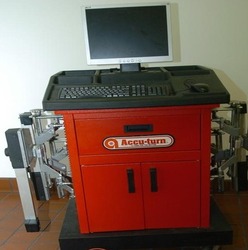
Knowing about these three basic adjustments coupled with asking educated questions can give the shop a little extra motivation to make sure your wheel alignment is done properly.
Asking for the before and after print outs can also increase your chances of a quality service. Modern wheel alignment equipment includes an on-board computer that has the specifications for all kinds of cars built right in to the software.
These machines also have a printer on board so your request for a printout should be no bother to the repair center. Don’t fall for the, we are all out of printer paper trick. Take the prints home and study both the specifications and the final adjustment settings.
The specs will provide a range of acceptable measurements. You want to make sure that your final settings are within these parameters. If they are not within tolerance a few problems can result. The two most common would be premature tire wear and the second would be a pulling condition.
Some people including professional mechanics think that you should have an alignment after every pot hole slam or other impact. This next page discusses why I don’t think you always need one when a car bumps a curb or other minor impact.
Discover what else can go wrong with the parts you use for steering as well as the parts that hold the vehicle up on my page about car suspensions. A popular item that is often up-sold and misunderstood is the idler arm. See how to test them and what questions to ask the shop when they recommend a wheel alignment and idler arm. Find out more about the covered material on this site. Find out why mechanics think every driver should learn more about auto repair.

